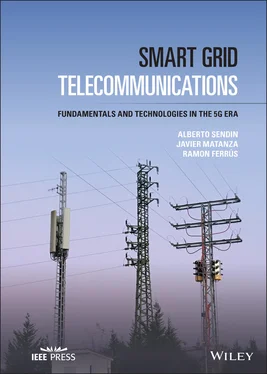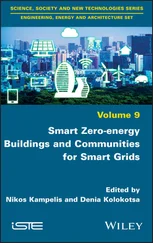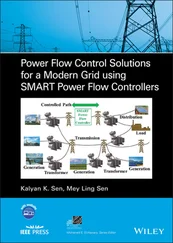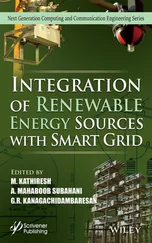Ramon Ferrús - Smart Grid Telecommunications
Здесь есть возможность читать онлайн «Ramon Ferrús - Smart Grid Telecommunications» — ознакомительный отрывок электронной книги совершенно бесплатно, а после прочтения отрывка купить полную версию. В некоторых случаях можно слушать аудио, скачать через торрент в формате fb2 и присутствует краткое содержание. Жанр: unrecognised, на английском языке. Описание произведения, (предисловие) а так же отзывы посетителей доступны на портале библиотеки ЛибКат.
- Название:Smart Grid Telecommunications
- Автор:
- Жанр:
- Год:неизвестен
- ISBN:нет данных
- Рейтинг книги:3 / 5. Голосов: 1
-
Избранное:Добавить в избранное
- Отзывы:
-
Ваша оценка:
- 60
- 1
- 2
- 3
- 4
- 5
Smart Grid Telecommunications: краткое содержание, описание и аннотация
Предлагаем к чтению аннотацию, описание, краткое содержание или предисловие (зависит от того, что написал сам автор книги «Smart Grid Telecommunications»). Если вы не нашли необходимую информацию о книге — напишите в комментариях, мы постараемся отыскать её.
Discover the foundations and main applications of telecommunications to smart grids Smart Grid Telecommunications,
Smart Grid Telecommunications
Smart Grid Telecommunications — читать онлайн ознакомительный отрывок
Ниже представлен текст книги, разбитый по страницам. Система сохранения места последней прочитанной страницы, позволяет с удобством читать онлайн бесплатно книгу «Smart Grid Telecommunications», без необходимости каждый раз заново искать на чём Вы остановились. Поставьте закладку, и сможете в любой момент перейти на страницу, на которой закончили чтение.
Интервал:
Закладка:
Distribution grid challenges are the ones that have been driving the evolution of the Smart Grid concept in the network control side. The paradigm of a static unidirectional network delivering electricity from the core to the edge has changed into an entangled mix of new technologies and assets, with varied properties, that needs to be organized. The new idea of a “platform” [42], rather than a “grid” that can serve the different Distribution grid stakeholders, has become popular due to its use in some major initiatives.
Automation tries to drive the grid toward becoming a self‐healing entity. Automation in utilities consists of Substation Automation (SA) and Distribution Automation (DA). Automation process started at substation level, mainly PSs (hence SA), and moved out toward the edge (hence DA), increasing its ambition to reach every corner of the grid with that kind of automatic signals driving electricity through the most appropriate routes (like information is routed in telecommunications networks, differences aside). The aid of ICTs and telecommunications in grid automation is highlighted in [43] with the term ADA (Advanced Distribution Automation). The ultimate objective of the self‐healing grid is to improve the service availability introducing efficiencies in the grid operation (less manual and field interventions).
The appearance of DER alters the traditional equilibrium of things in the Distribution grid. E.g., DG and EVs come with some caveats that change the landscape of traditional grid operation. On the more general side, operational procedures need to be modified as they can no longer assume that energy flow is not unidirectional (restoration manoeuvers may need power to be completely for the safety of people and assets). On the other, a greater visibility and control of the elements of the grid, including those of the new technologies close or in the Consumption Points, to enable the operational procedures.
Now the Smart Grid in the Distribution segment needs to be seen as the superposition of the grid with the new grid technologies, and a telecommunications network providing connectivity to any corner of the grid to measure, control, and remotely operate the different IEDs (Intelligent Electronic Devices) attached to the grid assets [35]. A different proportion of central and distributed intelligence will use this connectivity to run algorithms able to make autonomous decisions and perform sophisticated actions that will be monitored from UCCs.
1.6 Challenges of Telecommunications for Smart Grids
Telecommunication networks, systems, and the services they provide are defined to fulfill a set of technical requirements within the state‐of‐the‐art solutions and the affordable economic conditions.
Thus, not any telecommunications solution can fulfill the need of any service. However, from a pragmatic perspective, some needs and/or some industries may trim their requirements to the capabilities of existing telecommunications solutions.
From a practical Smart Grid implementation perspective, one of the main decisions when selecting telecommunication solutions is the option of deploying private telecommunication networks, as an alternative to using commercial telecommunication services from TSPs. It is often not a question or selecting one or the other, but how to select the best combination of both, leveraging the full control that private networks offer, with the use of TSP services that may be already available in third‐party deployed networks (TSPs'). In both cases, but probably more relevant when the services are provided by TSPs, there are two important aspects that need to be taken into account. The first one is the national regulation of the conditions under which any telecommunication solution is licensed in a given territory; the second, pretty much affected by the first one, is the network design and its implementation on field, together with the operation and maintenance aspects.
Thus, the service adequacy of a telecommunications solution needs to be evaluated considering the integration of several aspects, at least, the solution conception based on the requirements to be fulfilled, and its practical implementation within the constraints of network design decisions, regulation and business plans. As a consequence, the assessment of how the different Telecommunication solutions fit Smart Grid requirements must evaluate many different alternatives under a non‐evident set of considerations.
1.6.1 Telecommunication Solutions for Smart Grids
Smart Grid infrastructure refresh cycles are much slower than telecommunication's. In general terms, we could say that the useful lifetime of a grid technology is always higher than any telecommunication solution that could be used in it, with factors ranging from 1.2 to 2.5 (see examples in [44]). If a telecommunications solution is to be found for a specific Smart Grid need, it is not just the requirements, or the basic technology supporting it that deserves attention, but the way in which the telecommunication solutions are to be sustained over time and how to better approach this.
The consideration clearly exceeds technical aspects, but probably economic aspects as well, as the feasibility of modifying infrastructure aspects on the grid must be limited in order not to affect grid reliability or to interfere with normal grid operation. Thus, substations cannot be frequently stopped, and customers cannot be visited without a good reason.
There is an inherent risk of making wrong choices when deciding on the telecommunication solutions for Smart Grids:
The technology assessment period (including analysis, proof of concept, service adjustment, and tender process) may take so long that a relevant percentage of the product or service lifecycle is gone.
The network or service deployment rhythm, as it is encompassed with the grid infrastructure delivery, may take so long that a relevant percentage of the product or service lifecycle is gone.
If the selection of the technology involves a service provided by a TSP, the availability of the service or its service conditions may vary over time, and it may invalidate products developed to adapt to this service.
Utilities usually take some measures to adapt to these risks:
Private telecommunication network solutions are chosen, even if there are commercially available alternatives, to avoid that their investments or costs are decided outside their industry.
Access to niche telecommunication solutions and product vendors. Apart from the grid knowledge of many of these vendors, they offer their solutions with long‐term availability commitments.
Integration of telecommunication solutions and even technology inside grid elements. The use of assets that are intrinsically part of the grid (optical fiber cables, PLC, etc.) guarantee that they evolve as the grid infrastructure does.
Integration of replaceable telecommunication modules within the devices to be connected, or as separate boxes connected through simple standard interfaces, to minimize disruptions due to external changes.
All these precautions come with a price. Private telecommunications network solutions require an expertise that needs to be found within the utility, contracted as a service, or existing within niche TSPs. Niche solutions have the handicap that they are not usually best of breed, as they are not based on the ultimate knowledge and resources from market leaders; moreover, as the niche market may be comparatively small, the attraction of competitors is limited, so that it may end up with prices (costs) that are not competitive. Integration of telecommunication solutions within the grid requires that utilities open their grids to telecommunication experts so that the field they need to explore is available to develop and test new ideas; this might not be easy being the grid a place where safety and reliability of service is a key aspect.
Читать дальшеИнтервал:
Закладка:
Похожие книги на «Smart Grid Telecommunications»
Представляем Вашему вниманию похожие книги на «Smart Grid Telecommunications» списком для выбора. Мы отобрали схожую по названию и смыслу литературу в надежде предоставить читателям больше вариантов отыскать новые, интересные, ещё непрочитанные произведения.
Обсуждение, отзывы о книге «Smart Grid Telecommunications» и просто собственные мнения читателей. Оставьте ваши комментарии, напишите, что Вы думаете о произведении, его смысле или главных героях. Укажите что конкретно понравилось, а что нет, и почему Вы так считаете.












